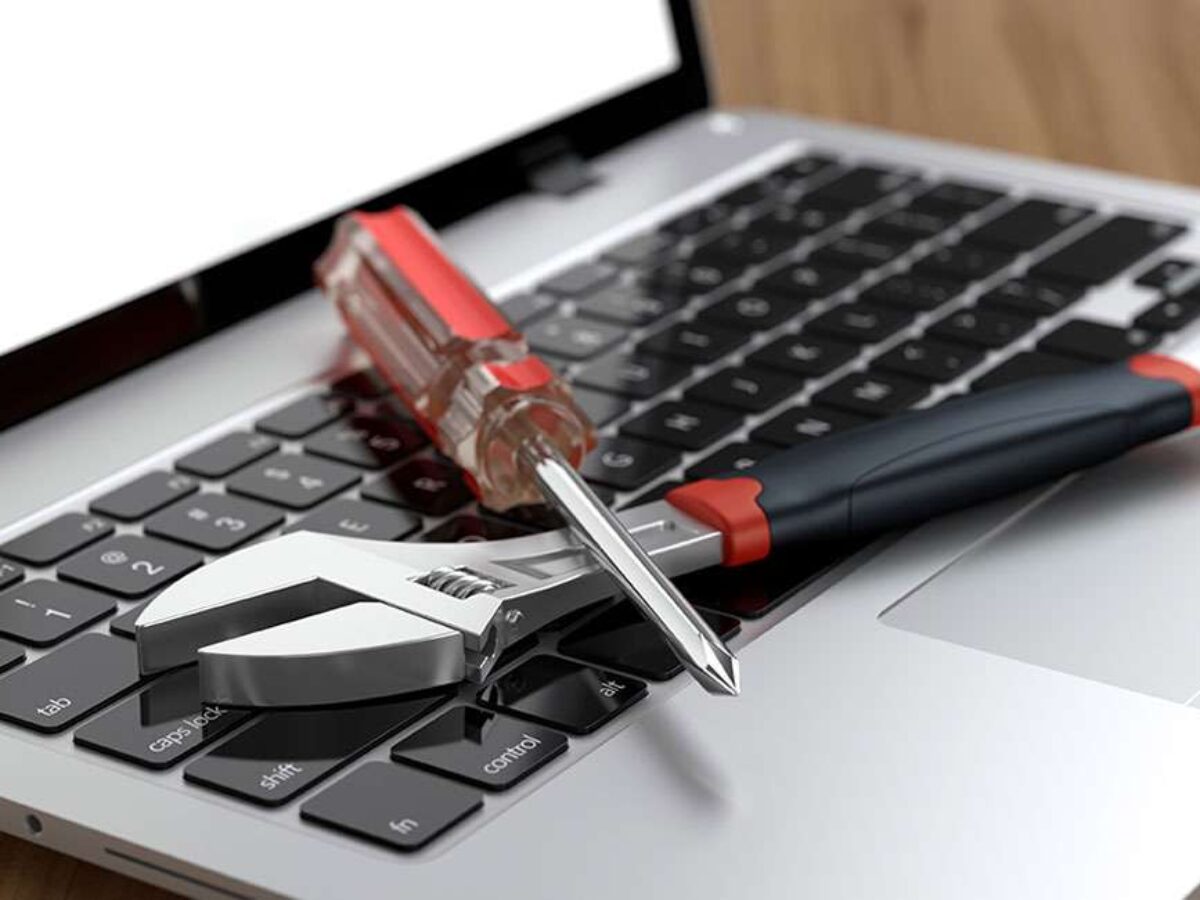Troubleshooting is a systematic process for determining the source of a problem in a computer system and correcting the underlying hardware and software problems.
Many use laptops daily for work, school, personal, and amusement. This is why when our laptops begin to malfunction, our lives come to a stop.
You may need to hire a professional to repair them. However, if you become conscious of these issues, you can resolve them independently.
Because our computers are among our most frequently used devices, we take special care to ensure they operate flawlessly.
Here are some of the most prevalent laptop problems and fixes you can try at home.
Read Also: How to fix common smartphone problems on your own
1. Low Battery Life
One of the most prevalent laptop issues is this. It’s also straightforward. In almost all instances, the problem is caused by the battery.
There is a method for you to find out. First, you can determine whether the battery has failed by removing it from the notebook and connecting it to the charger. If the laptop still powers on and functions typically, this indicates that your battery is malfunctioning.
Solution
1. Purchase a new battery
You’ll need to purchase a new battery for your laptop model in that situation. But, again, you can contact the brand’s support center for more information.
If the charger is connected and the battery is out, but the laptop still won’t power on, the issue may be with the charger.
Just to be positive, try using different wall plug points. Also, you may need to purchase a new laptop adapter now that the battery is back in the computer and isn’t charging.
Read Also:- Tips for setting up a home office with your laptop or PC
2. Check for Draining Software
It’s also worthwhile to look at the Software operating in the background if the battery drains faster. You can verify that by selecting “System” from the Windows “Settings” menu.
Next, select “Battery use” after switching to the “Battery saver” option. You will be given a list of the applications that use the most battery.
Click on any unusual software you don’t want to run in the background or shouldn’t be here, and then disable the “Allow this app to run in the background” choice.
2. Blue screen of death (BSOD)
One of the most dreaded issues on Windows computers is the Blue Screen of Death. Several factors may cause this error.
They may be connected to problems with both hardware and applications. For example, you might be able to restart the notebook in some circumstances, but you might not be able to in others.
Solution
1. Verify your drivers for adware and corruption
If you can restart Windows, use Windows Defender, or any other security program, you must quickly scan the system for viruses.
Before you perform the scan, please don’t neglect to update it. Then, you can be confident that it’s only sometimes the issue.

2. Upgrade your Drivers
Checking for outdated drivers and upgrading them is an additional safety precaution you can take. Entering Device Manager will allow you to do this.
If any hardware component has a yellow exclamation mark next to it, update the driver by choosing “Update Driver Software” from the context menu when you right-click on it, as we did with the keyboard.
Sometimes, the issue you’re having may be brought on by a recent upgrade. You can revert the update to the prior version if you are confident that a particular driver is the root of the problems.
3. Overheating
Another potential reason for a laptop to crash abruptly is an overheating processor or graphics chip. Again, the laptop’s heat near the ventilation may allow you to determine this.
Solution
Download SpeedFan, a free Windows temperature monitoring tool, if you want to be entirely sure. Then, your laptop’s CPU and GPU temperatures will be visible.
In any case, the fan may not be operating correctly or turned off entirely, which would explain the overheating. So, once more, transport your laptop to a service center if it is still under warranty.
If you feel confident, carefully open the laptop with internet guides. Then, brush all the grime off the surface or clean the fan. Carefully reassemble your computer after doing this.
4. Memory problems
A hardware failure of some kind may be the source of BSODs. For example, you can check the RAM in your laptop to see if it’s one of the parts that could malfunction.
Solution
Press the Windows and R keys on your laptop to execute a command. For example, enter “mdsched.exe” in the command window and hit “OK.”
A box that checks for memory problems will appear. You can verify the issue immediately, or the next time you turn on your laptop. Depending on your preferences, pick one.
Your laptop will launch the Windows Memory Diagnostics Tool to check for any RAM issues if you decide to do it right away.
If there aren’t any problems, the RAM is functioning correctly. However, if any mistakes do appear, you should have them replaced.
5. Hard drive failure
The hard disc should be checked to see if the RAM performs flawlessly. If this is not confirmed, your PC will be ceaselessly hanging.
Entering the File browser will allow you to do that.
Solution
To inspect a drive, right-click it and select “Properties.” Next, go to the “Tools” section of the page and like “Check.” You’ll discover them here if the hard disc is the issue.
Finally, run SpeedFan to check for any potentially challenging drive problems. The best action is to bring the problematic hard disc to the service center for replacement.
6. Inability to Connect to Wi-Fi
The most frequent issues we have with computers are Wi-Fi-related. For example, the job, game, or show is interrupted when the Wi-Fi connection fails or disconnects.
The causes can be anything from a laptop’s wireless hardware falling to the router and firewall blocking the link malfunctioning.
Solutions
1. Restart the modem and router by using the hardware switch
These kinds of equipment are vulnerable to firmware or hardware failures after operating for a long time. The Wi-Fi link might deteriorate or disappear entirely over time.
The current network problems can be fixed by restarting the device.
2. Ensure that Wi-Fi is activated
A physical switch for a wireless network is now available on many contemporary laptops. This switch is usually located on the keyboard and is accessed by the function (FN) shortcut.
3. Verify the Authencity of Your Wi-Fi password
Verify that no one with access to the router or modem’s administrative interface has altered the Wi-Fi password. If the password is incorrect or has changed, the laptop won’t be able to join the Wi-Fi network.
However, here are some how to’s to keep handy
- To remove the connection’s cache and preferences, reset the Wi-Fi adapter.
- To access the options, click the Taskbar and right-click the “Wi-Fi symbol.”
- The Status menu will appear after selecting the Open Network & Adapter Settings choice.
- The Network Connections window will appear after you scroll down and select the “Change adapter options” option.
- Locate the Wi-Fi option and use the right-click menu to pick “disable.” The Wi-Fi device will be disabled as a result. To activate Wi-Fi, use the same right-click menu. This ought to resolve the laptop’s Wi-Fi issues.
7. Laptop is running Sluggishly
The last thing anyone desires is for their laptop to suddenly or gradually slow down. However, routine upkeep and ongoing fixes must sometimes be improved to prevent computer lag.
No matter which version of Windows the notebook is running—Windows 7, 8.1, 10, or even 11—lagging can begin.
Solution
To identify the programs consuming all the resources, look in this area of the task manager.
- Press the keys Ctrl + Shift + Esc to open the task manager. Next, click on the “more details” link at the bottom if it is only displaying the names of the currently running apps.
- Find the most RAM, disc space, and CPU applications. For example, Firefox currently utilizes more than a gigabyte of RAM without being active. Users can also discover other programs with the same characteristics that can be stopped.
- Once the unwanted programs have been prevented from operating in the background, exit the task manager. Programs might restart when the computer boots up the next time.
8. Keyboard Inefficiency
You can anticipate that laptop keys will be among the first to break because they typically receive a beating. However, if you’re lucky, you might only lose the functionality of a few keys or your complete keyboard.
Solution
There may be a simple obstruction to blame for some buttons not functioning. Shake the laptop gently while it is upside down to see if this helps remove any grime or dust.
Although it might have an odd tone and appearance, it might work. Some other things you can do include:
1. Redownload Keyboard Drivers
One of the first things you can look for if there is an issue with all the keys is faulty keyboard drivers. Entering the Device Manager will allow you to do this.
If a yellow exclamation mark accompanies your keypad icon, you must re-download the required drivers. Find the correct keyboard drivers on the manufacturer’s download website for laptops.
This might assist in solving the issue. However, using a USB-powered keypad in the interim would be best.
2. Tighten The Keyboard Unit’s Link
If updating the drivers doesn’t resolve the issue, the keyboard unit’s link to the motherboard is presumably loose. This might not happen. Opening the chassis to reach all of the laptop’s internals would be best. Verify that the keyboard ribbon cable is correctly connected.
3. Take the laptop to the repair center
After everything is finished, you should change the keyboard. It’s easier than it seems. It’s necessary to do a little study before opening the laptop.
Once you have access to the keypad, remove it without harming the laptop’s interior. After that, all left is to position the keyboard correctly and connect the keyboard ribbon connection.

